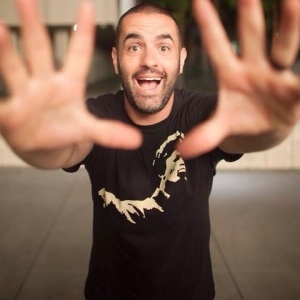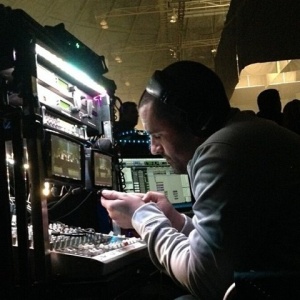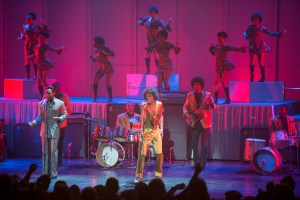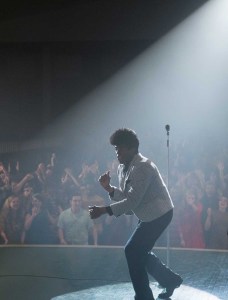
The sonic endeavor of Universal‘s Get on Up was to transport the audience to a live James Brown concert. Maintaining authenticity in every way possible was the goal of director Tate Taylor and his crew, including sound mixer Steven Morrow. Using original James Brown recordings and re-created live performances lensed by Stephen Goldblatt, transporting the movie theater audience to concert venue became possible. Said Morrow, “The director and studio were always really interested in making sure it was like going to a James Brown concert. You were going to hear the godfather of soul. Nobody can replace him so why would we try?”
To mix the film’s soundscape, Morrow used two Sound Devices 788T eight-track recorders and Protools 10. A combination of lavalieres and strategically placed room mics captured live performances delivered by the film’s cast, with Chadwick Boseman in the soul-driven shoes of James Brown. Lavaliere microphones ensured foley capture, while the room microphones served as the method for turning original James Brown recordings, blaring through speakers surrounding the stage, into simulated live performances. “We made sure everything was recorded,” said Morrow. “When it came down to performances on stage, it was essentially just surrounding the stage with speakers, and we would blast it so the musicians could hear it. The camera crews and camera operators would all be wearing ear protection like they were on a battlefield.”

In a collaboration with the props department, Morrow and team used historically accurate and fully functional vintage prop microphones for Boseman and bandmates to sing through. According to Morrow, the props department compiled a list, using historical photographs, of microphones needed to maintain the intended authenticity of Get on Up. Up to 20 different mics were gathered for the span of eras portrayed in the film. The film’s final soundscape has a heavy presence of the prop microphones, with a lavaliere catching words said by Boseman while away from his prop stage mic. Actual concert goers would never get to hear what a musician says off mic, but it was an element Morrow felt was necessary to enhance story. “About 70% of the performance we’d be getting James Brown through prop microphone. The other 30 we’d get him through the radio mic.”
While most of the film was shot in 300 year-old Natchez, Miss., and the rest in Jackson, playback helped Morrow and team create sonically accurate replicas of concert venues. “Playback for certain locations, such as the Apollo Theater, was the actual Apollo Theater recording,” shared Morrow. Though the crew never shot in the actual location, having the ambiance and tone of the Apollo Theater preserved in the pre-recorded tracks meant an automatic authenticity as playback was recorded. For the famous Boston Garden scene, playback was driven through the sound system of the arena used by production for added effect. “That gave it an open air, echo sound, as if it were the real deal.”

Another strategy mentioned by Morrow in terms of achieving both authenticity and modern quality was the Dolby sound mix. The combination of Morrow’s production recordings and the original James Brown tracks in the final Dolby mix made songs recorded more than 30 and 40 years ago sound like they could have been recorded in 2014.
According to Morrow, Goldblatt’s decision to shoot single camera aided the sound department both artistically and logistically. “He wasn’t doing it for sound, but it was very helpful. Then, you got to decide: ‘do I want it to sound like what the camera sees? Do I want it to sound like a wide shot?'” In a scene portraying a young James Brown walking down a road in a wide frame, energized from a boxing match and chanting his own name, Morrow was able to have boom operator Craig Dollinger stay with camera to allow for a realistic distance and ambiance. No other mics were necessary. This wasn’t always the choice when a wide shot was taken, however. In another scene, young James Brown is seen running through a forest with his mother. Lavalieres were used to capture clean dialogue between mother and son, while a well distanced boom mic heard forest ambiance and provided a more realistic option. “Sound mixing isn’t necessarily an art 90% of the time. You’re just trying to provide the cleanest sound possible for the editors in postproduction to do what they need to do,” said Morrow.
 A scene set in Vietnam allowed Morrow to combine art and the goal of achieving clean, strategic sound. The scene involved an airplane, its passengers, James Brown and his band, and a surrounding chaos of explosions and gunfire. Without the presence of actual chaos, Verbal cues were shouted to the actors to provoke reactions. Morrow knew sound would be compromised by such verbal direction. As a remedy, Morrow used a Shortcut from 360 Systems. Shortcut is a music editor with ten hot-keys, programmable to any sound effect desired. With this in the hands of production’s first assistant director, a more realistic environment was created for the actors and cleaner sound achieved. “We walked over to the first AD and said, ‘here you go, push this button for an explosion and this button for gun shots,'” explained Morrow. “Throughout the scene she could push the right button at the right time for everybody to react correctly. Later on, obviously, they’d replace those sounds with actual explosions, but at least they’d have something they could replace with a louder, cleaner sound effect of the same sound.”
A scene set in Vietnam allowed Morrow to combine art and the goal of achieving clean, strategic sound. The scene involved an airplane, its passengers, James Brown and his band, and a surrounding chaos of explosions and gunfire. Without the presence of actual chaos, Verbal cues were shouted to the actors to provoke reactions. Morrow knew sound would be compromised by such verbal direction. As a remedy, Morrow used a Shortcut from 360 Systems. Shortcut is a music editor with ten hot-keys, programmable to any sound effect desired. With this in the hands of production’s first assistant director, a more realistic environment was created for the actors and cleaner sound achieved. “We walked over to the first AD and said, ‘here you go, push this button for an explosion and this button for gun shots,'” explained Morrow. “Throughout the scene she could push the right button at the right time for everybody to react correctly. Later on, obviously, they’d replace those sounds with actual explosions, but at least they’d have something they could replace with a louder, cleaner sound effect of the same sound.”
Regarding working with Taylor, Morrow stressed an appreciation for his collaborative nature. “He says, ‘hey, that’s your job. Do whatever you need to do and if I need to do anything different for you, let me know.'”
Get on Up will be released on DVD and BluRay, Jan. 6.





